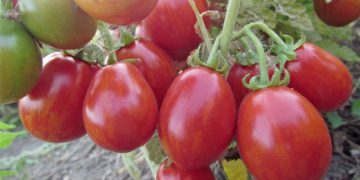#Kyrostomato#early-maturingvariety#high-yield#drought-resistant#disease-resistant#versatile#freshconsumption#preservation#tomatodiseases#Phytophthora#drymattercontent#lycopenecontent#openfields
Tomatoes are a staple crop for many farmers around the world, and choosing the right variety can make all the difference. In this article, we will take a closer look at the Kyros tomato, a versatile and reliable option that has gained popularity among farmers due to its excellent yields and resistance to common tomato diseases.
The Kyros tomato is an early-maturing variety, taking only 80-84 days from seedling to fruit ripening. It grows to a height of 45-50 cm and has a determinate growth habit, making it a compact and bushy plant with low foliage. The fruit is round-oval in shape with a small blunt tip, and weighs between 90-120g. The unripe fruit is green with a blurry green spot near the stalk, which disappears as the fruit ripens and turns red. Each fruit has 3-4 seed chambers, with an average seed yield of 0.4% of the fruit’s weight.
The Kyros tomato has excellent flavor and texture, with a sugar-acid ratio above 7, making it ideal for both fresh consumption and preservation. It is also a drought-resistant variety, with good resistance to common tomato diseases such as Verticillium wilt, Fusarium wilt, and cracking. In unfavorable years, the incidence of Phytophthora infection is only 0.5-1.0.
In terms of yield, the Kyros tomato performs well, producing up to 56 (up to 80) tonnes per hectare in non-Chernozem regions, and up to 120 tonnes per hectare in the Volgograd region. It has a high early yield, producing 47 tonnes per hectare or 83% of the total yield. The dry matter content is between 6-7%, with a lycopene content of 3.3 mg% (6.4 mg/100 g).
Overall, the Kyros tomato is a reliable and versatile option for farmers looking for a high-yield and resilient variety. It is recommended for cultivation in open fields in regions with unstable weather conditions during the growing season (May-September). Its sturdy fruit can be stored for up to 30 days after harvesting, making it a valuable crop for both fresh consumption and preservation.






























